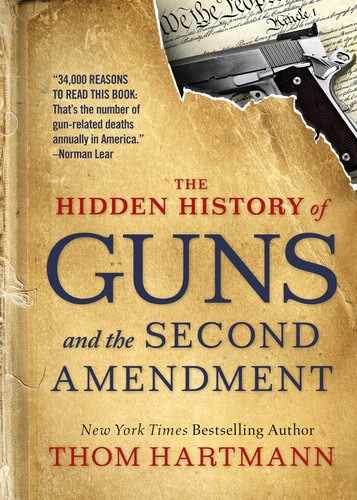CHAPTER 2
The Sanitized History of America
Political language is designed to make lies sound truthful and murder respectable, and to give an appearance of solidity to pure wind.
-George Orwell, Politics and the English Language
The United States’ expansion and conquest in the late 18th century, through the 19th century, and into the 20th century is a history written by white men, inked in the blood of Native Americans, and built on the broken and bloodied backs of enslaved people brought here from Africa.
From 1791, when the Bill of Rights went into effect, until the end of the Civil War, the Second Amendment protected the rights only of white men to own guns. This is simply because until the ratification of the 14th Amendment, states determined who was recognized as a “person” protected under the Constitution.
Initially, in most states, this meant that white men who owned land and paid taxes were the only people considered full citizens under the Constitution.
In the South, white men with guns formed slave patrols to control slaves and formed posses to hunt escaped slaves.
Individuals on the frontier organized to “protect” recently stolen land and to ensure that Native Americans continued to march westward at the point of a gun.
The early 19th century brought us the original Texas Rangers, who were well-armed, and though Hollywood now tells stories about the Texas Rangers as noble lawmen serving on a dangerous frontier, Roxane Dunbar-Ortiz describes a different reality in her book Loaded: “Like slave patrols in the Deep South, the Texas Rangers—formed primarily to kill Comanches, eliminate native communities, and control colonized Mexicans to take their land—also hunted down enslaved Africans escaping to freedom. They began to operate in the 1820s, even before . . . Texas had seceded from Mexico in 1836, when Mexico formally outlawed slavery.”1
What many schoolchildren learn about this period is sanitized. Worse yet, what many adults think they know about this period is not only sanitized but steeped in pop cultural references that glamorize the period while glossing over the utter brutality of American history.
Americans learn about the expansion of America, about the Louisiana Purchase, and about manifest destiny. The images of this period are of elite sharpshooters on the frontier: Daniel Boone, Davy Crockett, and James “Jim” Bowie, to name a few.
And as when there is a mass shooting today, most Americans remember the man who shouldered the rifle more than the person who stared down the barrel. Americans, particularly white Americans, simply ignore the most brutal aspects of the massive slave economy that this country was built on.
American culture and education have hidden the brutality of American history and slavery so effectively that Nevada rancher Cliven Bundy wondered in 2014 whether black Americans were “better off as slaves.”2 More recently, former Alabama Senate candidate Roy Moore told an audience that “[America] was great at the time when families were united— even though we had slavery—they cared for one another.”3
Likewise, when contemplating the Louisiana Purchase, history talks of Napoleon selling French territory to Thomas Jefferson. The truth is that the Native American population dramatically outnumbered the French population in the Louisiana Territory at that time.
As well-armed Americans poured across the newly purchased territory, Native Americans had three options: continue to flee westward; submit to American conquest and assimilate; or fight back against the rifle-toting American frontiersmen, which would only give more justification for Americans to respond with more force.
Even during this period of slavery and genocide, white Americans didn’t necessarily see themselves as murderers and plunderers. The 19th century in America was a period of intense religious revival. On the one hand, the abolition movement rooted itself in Christianity. On the other hand, slave owners pointed to Bible verses showing that slavery had been legitimized in the Old Testament and that black people were heathens who had fallen from God’s grace, so slave owners were in fact helping their slaves along the road to salvation.
Native Americans were similarly called heathens and beasts, justifying the murder of those who wouldn’t convert and then the taking of their land. It was, after all, God’s will and manifest destiny that Americans continue to settle westward. Thus, the American frontiersman set out with his rifle, seeking his God-promised homestead and willing to kill any heathen that stood in his way.
For much of American history, most guns were owned by slaveholders and frontiersmen; urban Americans had little use for guns.
Guns were tools used to hunt animals for food, to keep slaves in line, and to force Native Americans to submit to American conquest, not symbols of manhood or cultural identity. The gun-manufacturing industry wasn’t yet selling guns on the mythology of the Minuteman.
But through the 19th century, private gun ownership still wasn’t particularly common. Historian Michael Bellesiles told the Economist in 1999, “It would appear that at no time prior to 1850 did more than a tenth of the people own guns.”4
In the years following the Civil War, though, private gun ownership exploded. The explosion of guns in private hands was in part because of the rise of private rifle clubs and paramilitary groups like the Ku Klux Klan, and in part because of savvy marketing by Oliver Winchester, founder of the Winchester Repeating Arms Company.
To understand the roots of the Second Amendment and the roots of American gun culture today, it’s vital to examine America’s brutal history of gun violence.
It is comfortable to tell a history of America that glamorizes the Old South by ignoring the brutality of slavery. It is easy to turn the frontiersman into a folk hero by breezing over the racism and guerrilla violence that marked the frontlines of America’s expansion westward.
But such comfortable histories of America do a disservice and prevent a true understanding of the cultural depths of America’s gun-violence epidemic, which, in turn, prevents a clear-eyed assessment of ways to address the problem at its roots.
